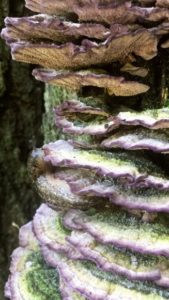By Kari Hemmert, Seasonal Farm Educator

April showers might bring May flowers, but June rains have brought us something just as beautiful: Mushrooms! If you look closely next time you’re outside, you’ll be shocked to see them everywhere, including the middle of your lawn. Just like wildflowers, trees, and animals, different mushrooms thrive in different seasons. However, it is not until temperatures and humidity are just right that these little fungal beauties pop up to spread their spores wherever the wind will take them.
As a kid there seemed to be something magical about mushrooms. Maybe it was all the myths about fairy rings, or maybe it was something else, but I’ve always found them captivating. You can understand then, why I’ve been so giddy about all the fungal growth in the parks lately. I’ve been coming in early or staying late at work, so I can hit the trails armed with my camera and a sense of adventure! There are mushrooms in all shapes and shades from shocking red scarlet cups, to the alien-like coral fungi hiding on Gallant Woods’ primitive trail. One recent morning, I spent almost five minutes watching a slug happily chew on a breakfast of Violet Toothed Polypores, which have the most vibrant purple shades when fresh! Across the street at Gallant Farm, I found tiny Inky Caps dissolving into the black goo that gives them their name. I’ve even seen the giant Dryad Saddle mushrooms from the spring wilting away to create an image reminiscent of Salvador Dali’s melting clocks.

My latest find was a clear, yellowy-white, gelatinous fungus that looked like a pile of brains covering an entire tree stump! This weird mushroom, called a Pale Jelly Roll, would probably look more at home on an alien planet than in the middle of Delaware County. Like other mushrooms that grow on wood, this bizarre jelly is a Saprobe. This is just a fancy name for fungi that help break down decaying matter, including the parts of trees that few other living things can digest. In turn, those rich nutrients get returned to the soil of the forest floor and the circle of life goes on.
Not all mushrooms care for the forest’s dead though; others are the lifeforce of the forest. Many that grow straight out of the ground are “mycorrhizal” and live in symbiosis with the roots of trees and green plants around them (“rhizo” means “roots”!) Beneath the soil is a microscopic marketplace where all forms of life, invisible to the naked eye, happily barter for life-sustaining nutrients. Mushrooms are just the most visible part of even greater fungal organisms, called “mycelium,” which colonize the soils, wood, and even plants. Mycorrhizal mycelia gather up nutrients like nitrogen and phosphorus, which they feed to the roots around them. The fungi are paid back with a generous helping of fresh, photosynthetically-produced sugar from the surrounding greenery!
Without fungi, dead trees would pile up, never returning to the soil, and our living trees and plants simply could not thrive. It’s complex relationships like this that seem to confirm my childhood suspicion that the forests hold all kinds of magic, if you just know where to look.

Look in your yard or come to the parks soon to check out all the diverse summer mushrooms! Examine the trees closely and the ground along the trail edges. What do you see? Where is it growing? You might bring out an old recycled makeup compact or hand mirror, so you can take a glance at the underside of the mushroom without picking it. Is the underside gilled? Smooth? Does it have tiny pores, or “teeth”? All these traits can give us clues that help solve the mystery of what mushroom we’re looking at. However, some mushrooms are so similar that you can’t tell species apart without using chemical tests or a microscope. I think that’s why I love mushrooms so much. They’re part of a beautiful, bizarre world that I’ll never be able to fully conquer!
To learn more about these beauties and how they help the forests, meet us this Sunday, July 1, 10 a.m., at the Gallant Woods Park shelter area.







